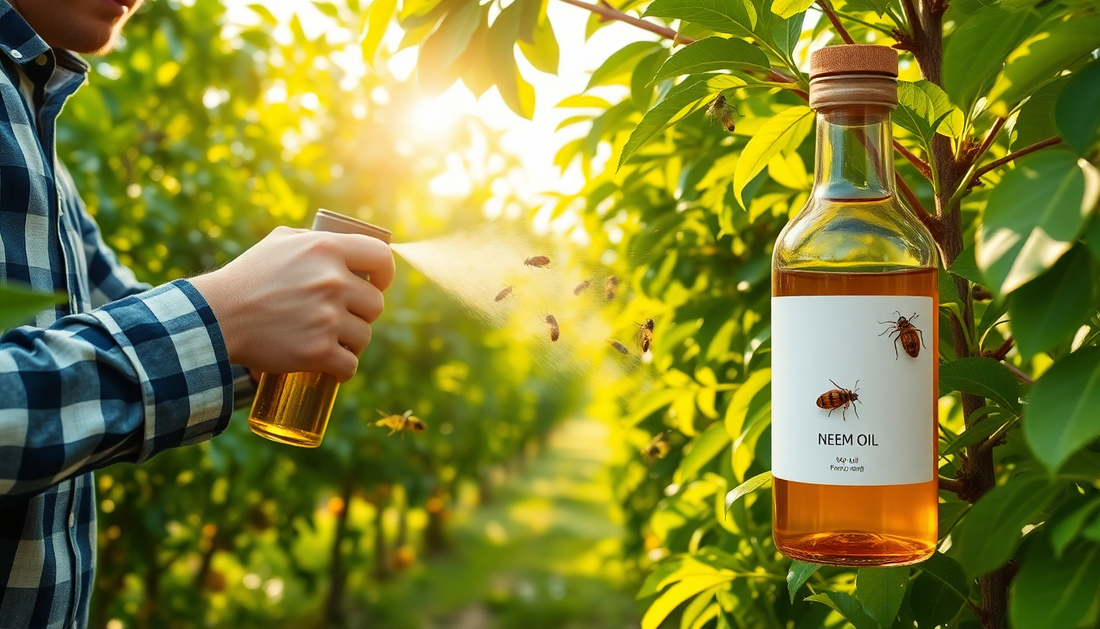
How to Use Neem Oil for Pest Control in Fruit Trees
Maintaining a healthy and thriving fruit tree can be a rewarding experience, but it often comes with the challenge of managing pests and diseases. One natural and effective solution that has gained popularity among gardeners and orchardists is the use of neem oil. In this comprehensive guide, we'll explore the benefits of neem oil and how to effectively utilize it to protect your fruit trees from a variety of common pests.
Understanding Neem Oil
Neem oil is extracted from the seeds of the neem tree, a native of India and other parts of Asia. This versatile oil has been used for centuries in traditional medicine and as a natural pesticide. Neem oil contains a compound called azadirachtin, which acts as a natural insecticide, repellent, and growth regulator for a wide range of pests.
The Benefits of Neem Oil
- Broad-Spectrum Pest Control: Neem oil is effective against a variety of pests, including aphids, mites, whiteflies, caterpillars, and even some fungal diseases.
- Organic and Natural: As a plant-based product, neem oil is a safe and environmentally-friendly alternative to synthetic pesticides.
- Systemic Action: When applied to the plant, neem oil is absorbed and transported throughout the plant, providing long-lasting protection.
- Minimal Toxicity: Neem oil has low toxicity to humans, animals, and beneficial insects, making it a safer choice for your garden.
- Versatility: Neem oil can be used as a foliar spray, soil drench, or even as a dormant oil application to control pests at different stages of their life cycle.
Preparing and Applying Neem Oil
Before using neem oil on your fruit trees, it's important to follow the proper preparation and application methods to ensure maximum effectiveness and safety.
Mixing Neem Oil
- Start with a high-quality, cold-pressed neem oil. Avoid using lower-quality or adulterated products.
- Mix the neem oil with a suitable emulsifier, such as a mild liquid soap or a commercial neem oil emulsifier, to help the oil blend with water.
- Dilute the neem oil mixture according to the manufacturer's instructions, typically around 1-2% neem oil in water.
- Stir the mixture thoroughly to ensure a homogeneous solution.
Applying Neem Oil
- Choose the appropriate time to apply neem oil, typically in the early morning or late afternoon when temperatures are cooler and the plant's pores are open.
- Thoroughly coat the entire plant, including the undersides of leaves, stems, and branches, to ensure complete coverage.
- Reapply neem oil every 7-10 days, or as needed, to maintain protection against pests.
- Be sure to cover the soil around the tree's base as well, as neem oil can also be effective as a soil drench to control soil-borne pests.
Targeting Common Fruit Tree Pests with Neem Oil
Neem oil is effective against a wide range of pests that can affect fruit trees. Here are some of the most common pests and how neem oil can be used to control them:
Aphids
Aphids are small, soft-bodied insects that feed on the sap of plants, causing stunted growth, leaf curling, and the spread of plant diseases. Neem oil disrupts the feeding and reproduction of aphids, effectively controlling their population.
Spider Mites
Spider mites are tiny arachnids that can cause significant damage to fruit trees by feeding on the leaves, leading to discoloration, webbing, and reduced photosynthesis. Neem oil suffocates and dehydrates spider mites, providing effective control.
Caterpillars
Caterpillars, such as the fruit tree leaf roller or the codling moth, can be a major threat to fruit trees, causing damage to leaves, flowers, and developing fruit. Neem oil disrupts the feeding and development of caterpillars, preventing them from causing further harm.
Whiteflies
Whiteflies are small, winged insects that feed on the underside of leaves, causing yellowing, wilting, and the spread of plant diseases. Neem oil disrupts the life cycle of whiteflies, making it an effective control measure.
Fungal Diseases
In addition to its insecticidal properties, neem oil can also be effective against certain fungal diseases, such as powdery mildew and black spot, by disrupting the fungal spores and preventing their spread.
Integrating Neem Oil into Your Fruit Tree Care Regimen
To achieve the best results with neem oil, it's important to incorporate it into a comprehensive fruit tree care regimen that includes proper pruning, watering, and overall plant health maintenance.
Timing and Frequency of Application
Apply neem oil at the first sign of pest activity or as a preventative measure, typically every 7-10 days during the growing season. Adjust the frequency based on the severity of the pest problem and environmental conditions.
Combining with Other Organic Practices
Neem oil can be used in conjunction with other organic pest control methods, such as introducing beneficial insects, using physical barriers, or applying horticultural oils or insecticidal soaps.
Monitoring and Adjusting
Regularly inspect your fruit trees for signs of pests or disease and adjust your neem oil application schedule accordingly. Be prepared to reapply neem oil if new infestations occur.
By incorporating neem oil into your fruit tree care routine, you can effectively manage a wide range of pests and diseases while promoting the overall health and vitality of your trees. With patience, diligence, and a commitment to organic gardening practices, you can enjoy a bountiful harvest of delicious, pest-free fruit.
Conclusion
Neem oil is a powerful and versatile tool in the organic gardener's arsenal. By understanding its benefits, proper application, and targeting specific pests, you can effectively protect your fruit trees and enjoy a thriving, productive orchard. Remember to always follow the manufacturer's instructions, observe safety precautions, and be patient as neem oil works gradually to restore the balance in your garden ecosystem.
Happy gardening!







No comments